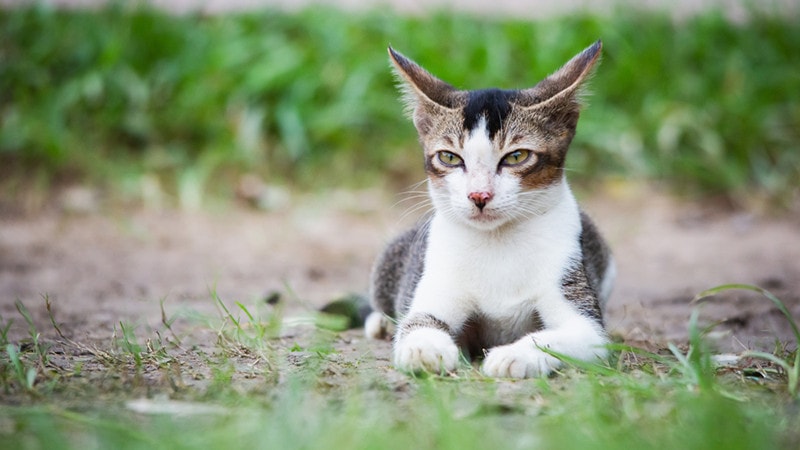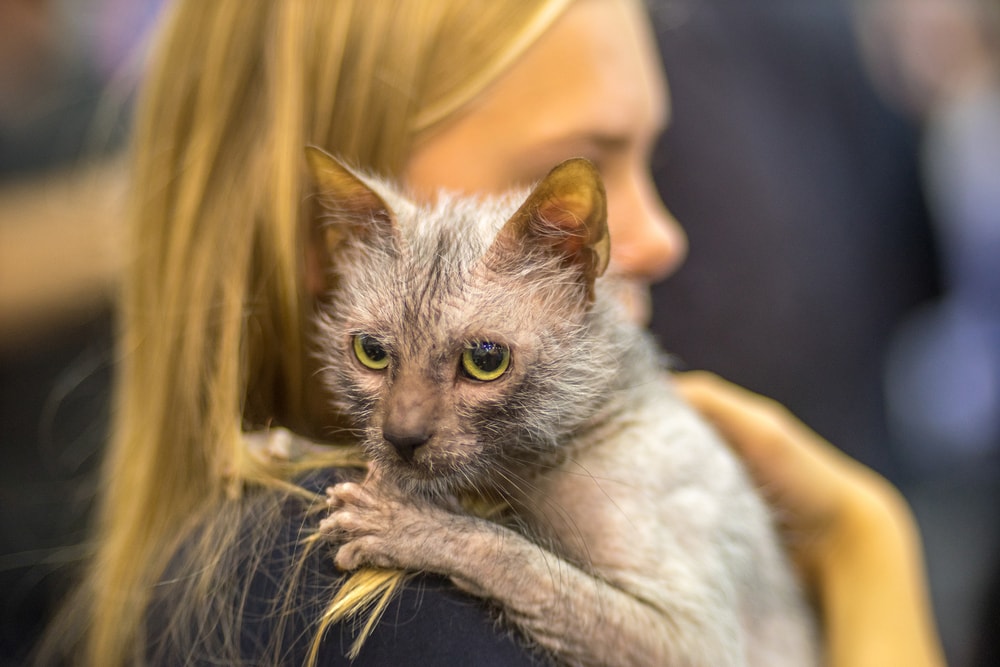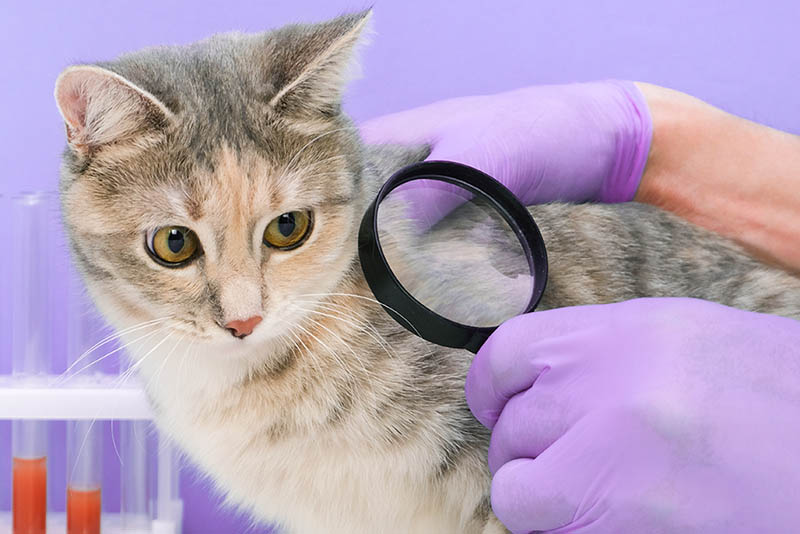What Is My Cat’s IQ? Vet-Approved Facts & Tips

Updated on

Cats are witty creatures: there’s no denying that. Our fluffy babies are not only fast, agile, and curious but also very smart. So, if you own a cute little fur ball, you’re probably wondering: what is my kitty’s IQ? We hate to break it to you, but there are no scientifically accurate ways to measure a cat’s IQ level.
These tests are tailored for humans, not felines. That said, there are some tried-and-true ways to figure out exactly how smart your four-legged friend is. And, with the right approach, you should be able to help the cat keep its mind sharp or even perfect it. Join us, and let’s hop into the exciting world of feline intelligence!
Cat vs Human Brains: What Do They Have in Common?
On average, the brain of an adult human weighs three pounds or 2% of the total body weight versus an ounce (0.06 pounds) and 1% of body mass in cats. But don’t count our feline friends out just yet! Size doesn’t always play a key role in intelligence. Instead, the structure and the surface folding make all the difference. And in this regard, cats and humans are 90% alike.
That explains why kitties often react like we do. However, at this stage of evolution, cats aren’t as good at making decisions. The cerebral cortex of a cat contains roughly around 250 million neurons; humans pack up to 16 billion. Based on this data, scientists believe that a two-year-old human baby matches the intelligence of a fully grown feline.

How Does the Brain of a Feline Function?
The cerebral cortex is responsible for creating long- and short-term memories and aids in solving problems based on old and new experiences. This is true for humans and cats. It’s been proven that felines rely on stored memories (up to 10 -14 years old) to do routine things in their daily lives. Also, they can learn how to do stuff by watching fellow fur babies or even from their human parents.
That’s why they’re sometimes caught pushing doors to open them, pulling drawers in, and even operating light switches (this rarely happens, but it has). Lastly, felines can attach feelings and emotions to certain events, places, and humans. This includes both good and bad emotions, by the way.
Signs of Cat Intelligence in Real Life
Just like human babies, cats are quick to learn and react to their names. Plus, while they don’t quite understand our languages just yet, cats are capable of distinguishing between different voices. They respond to familiar voices while keeping their distance when hearing a stranger talk. More than that, they can “decipher” our emotions.
That’s right: cats can sense joy, happiness, sadness, and fear. And, when facing something for the first time, they might watch your reaction and act accordingly. With that, felines are stubborn and persistent (a sign of intelligence) and won’t necessarily follow your lead no matter how much praise and snacks you give them.

What Can a Domestic Cat Do With Its Brain?
Cats are quick learners and use the skills gained through new experiences to up their wits. More importantly, these creatures are capable of putting together things that they just figured out with previous knowledge. This way, they get better at solving new problems and overcoming challenges. Unfortunately, our species hasn’t yet found a way to communicate with felines properly.
That’s why at this moment, we can’t really tell the exact scope of their cognitive abilities. We do, however, know that associative learning is another impressive skill in a feline’s arsenal. In the wilderness, they mostly listen to their biological clocks, but pet kitties won’t mind “changing the schedule” a bit to fit into your lifestyle.
Just How Smart Is Your Cat? A Quick Test
Does your fluffy family member come running toward the door the second you open it? Do they rush through the kitchen when you open a can of delicious food? Have you ever caught them scratching at the front door, asking you to let them go outside? And what about meows: does the little troublemaker call you when they want to eat? Can they follow your finger/hand when you’re giving directions?
These are all clear signs that you’re living with a feline mastermind. Cats also excel at object permanence. Grab a toy, snack, or any other object, and make sure the cat can see it. Now quickly hide it inside a drawer, behind a box, or in your own pocket. Watch closely: is the kitty turning around and leaving, or is it looking for that toy/food or trying to open that drawer? If so, that means it understands the permanence of objects.

What About a Feline’s IQ Level?
Scientists and researchers don’t conduct Intelligent Quotient (IQ) tests on cats because they don’t work on any species other than humans. Earlier, we mentioned that cats have the brains of a two- or three-year-old human toddler, and that’s the most accurate description of a feline’s mind. If your bud learns tricks faster than its peers and puts object permanence to good use, that makes it a smart and capable pet.
This is important: cats are never used for guarding or watching over something. They aren’t recruited for search-and-rescue missions or bomb detection. But that doesn’t mean they’re not as intelligent as dogs. It’s just that the mind of a feline works a bit differently.
Abyssinians and Siamese: The Smartest Cats
Looking for the brainiest kitty to adopt as a fur baby? Well, we have just the right list for you. While all cats are smart, some of them have a slight edge over the competition. Abyssinians, Bengals, and Siamese cats are widely recognized as the most intelligent breeds. The list also includes Burmese, Havana, Korat, and Savanna cats. So, what do these felines have in common?
They’re all big fans of socializing with fellow cats, other pets, and humans. And the more they interact with the world, the smarter they become! That’s why early socialization is so important for your furry bud. That said, every cat is different; plus, it all comes down to how you train and exercise with them.

Can You Boost a Pet Kitty’s Intelligence?
Want to make your cat the smartest fur ball on the block? It’s very well possible! Much like a pup, kit (baby rabbit), or human baby, kitties evolve rapidly and learn new things every day. And we are responsible for creating the perfect environment for them to hone their skills and grow into feline geniuses.
- Start the training early. Cats don’t stay young forever: their brains do get old. But, if you start training the feline while it’s still a kitty, you can help their mind stay sharp for a very long time. So, make sure you give the furry friend enough physical and mental training.
- Exercise with the cat daily. Repetition is the mother of learning and success. Exercising and playing with the cat every single day (yes, even on the weekends) is crucial. This way, you can create a healthy routine that the cat’s brain will become accustomed to and even look forward to.
- Introduce obstacles. In the wilderness, cats have enough obstacles to overcome. To recreate that in an indoor environment, invest in paper bags, cardboard boxes, tall shelves, and cat trees. The more corners the kitty has to squeeze through and barriers to jump over, the better.
- Play hide-and-seek with it. Nothing stimulates a feline’s mind better than encouraging them to find things. Hiding delicious snacks all over the house is a great place to start. You can also make noises with a bell to “call out” to the pet and have them chase the sounds.
- Don’t forget the dragging game! We’ve all done this: you attach a piece of ribbon, feather, or sock to a string and move it in front of the cat. If you pull it back, the kitty will start following it while trying to come up with ways to grab it. This is a great game for brain stimulation.
- Use treat-dispensing toys. Puzzles should be a part of it as well. You can either pick up some brain-heavy games or buy a treat dispenser. These things are designed to trigger a cat’s natural hunting and exploration instincts and work their feline minds.
- Make the kitty put in work. Obesity is a huge problem for domestic cats. When a feline is overweight, it prefers to sleep instead of playing or exercising and loses interest in solving puzzles. Start by putting their food bowls and favorite toys on an elevated ground and go from there.
- Introduce a new pet. A younger, more curious, and active doggo or kitty can breathe new life into your OG cat’s boring routine. This is important: if your old pet doesn’t seem to follow the new one immediately, don’t push it. Let the furry friend select the pace by themselves.
Final Thoughts
In the wilderness, cats are independent, self-relying creatures that use their brains to catch rodents, escape predators, and find a comfy spot to live in. Domestic felines are just like that: they are smart, bold, and curious, which is the true nature of a hunter. Unfortunately, there are no means of telling just how intelligent our furry buds are.
But cats have proven to be very well capable of navigating the environment, solving complex tasks, and creating strong, meaningful bonds with their pet parents. This is obvious without any IQ tests. So, best believe your cat has already figured you out and knows exactly how to get what they want and stay in your good graces!
Featured Image Credit: Ranganathan Iyer, Shutterstock











